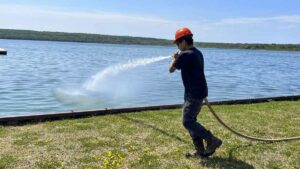This story was updated July 27, 2023
WIIKWEMKOONG—Wikwemikong (Wii-ni n’guch-tood LMS and Wikwemikong Ontario Works) supported Elaine Trudeau with organizing and funding the recertification of 37 firefighters—a total of eight crews—to be deployed to help combat regional forest fires that are currently plaguing parts of the province. Sheguiandah and Sagamok First Nation also had members of its fire department trained in this capacity.
“In order for them to take part in this advanced paid firefighting training, they needed to be qualified firefighters, meaning they need their valid first aid and previously will have taken a SP100 course, which is the firefighting course,” explained Elaine Trudeau, contract liaison officer and technical expert for Outland Reforestation Inc., which provided the training.
“Each qualified firefighter that participated was able to be recertified in either their SP100 (wildland firefighter training) course or their SP200 course, which is a crew boss course,” Ms. Trudeau added. “The course was quite intense as it was a few days of hands on work, where they went out in the field doing water pump set up and hose lay, working as if they were actually on the fire line. Some of the firefighters also did a chainsaw refresher, to Ministry of Natural Resources and Forestry standards, where they go out and actually cut trees and buck them up.”

Ms. Trudeau noted that many of the firefighter participants have years of qualifications, such as herself, who took her SP100 course in 1998 followed by the SP200 course in 2002.
Ms. Trudeau says there are five crews guaranteed to go if the request for crews comes in from the MNRF with three crews on standby.
“We typically cover the east region as a majority of us are from here, however if there are no fires in the east region and the west region is needing firefighters, then that’s when we get deployed when the request from MNRF comes in,” Ms. Trudeau added.